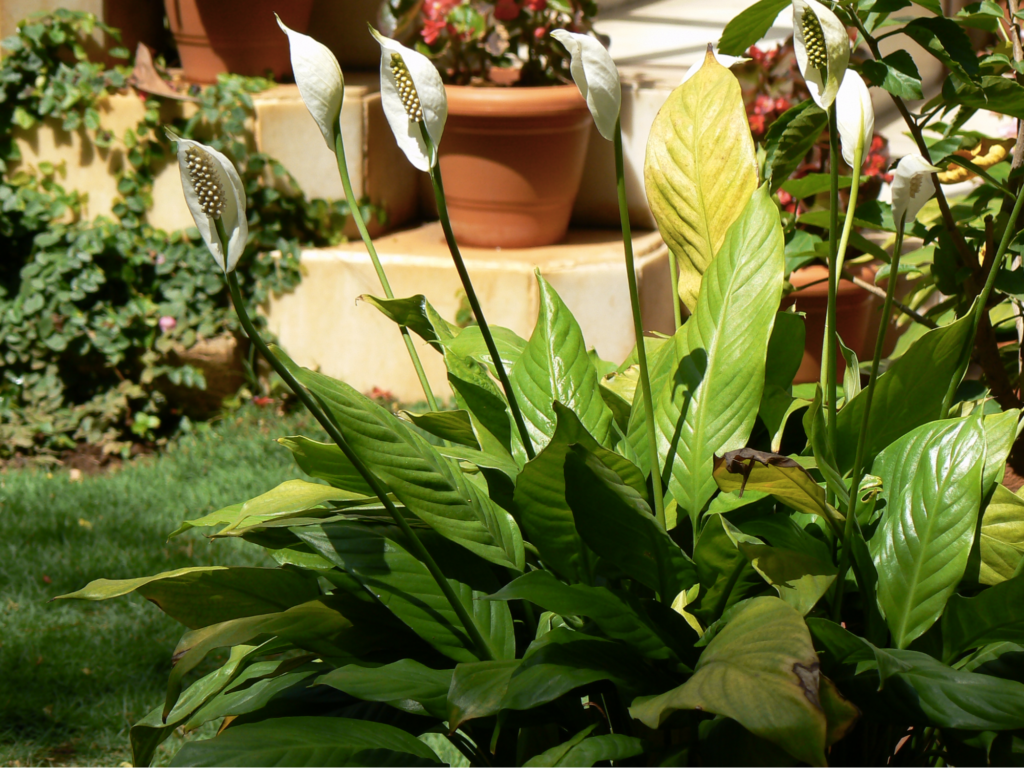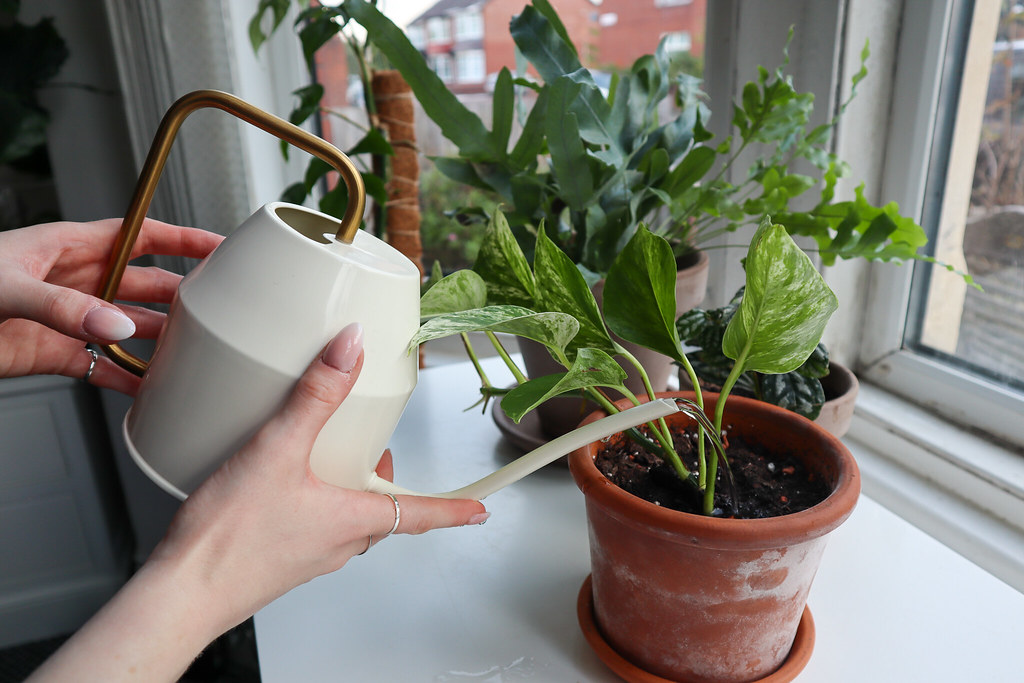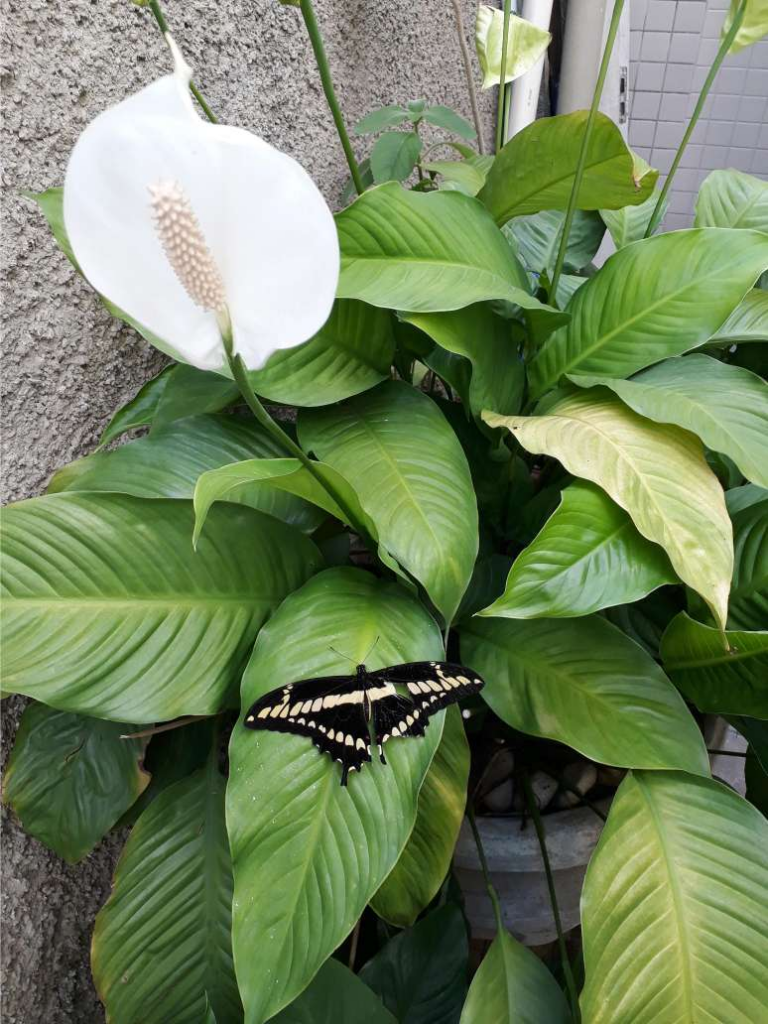Because of their exquisite white blossoms, peace lilies (Spathiphyllum spp.) are beloved by many people. Still, they are also adorable even when they are not in bloom. Even if they didn’t lower, peace lilies are still cultivated because of their gleaming, exquisite green leaves that are really alluring.
That is, until the foliage seems less than fantastic, which may happen when the leaf tips turned brown- a regular occurrence in gardens

Temperature changes, sunburn, and dried soil from underwatering are some causes of brown leaves on peace lilies. Low humidity causes the peace lily to lose too much moisture from the leaves, which causes the leaf tips to brown.
There are a lot of potential causes for the browning of leaves of peace lilies, and the most frequent causes will be covered in this article.
RELATED: How To Divide Peace Lily: All That You Need to Know
Main Causes of Brown Leaves of Peace Lilies

1. Plant Age
You may naturally be rather frightened if the lower and older leaves of your Peace Lily begin to turn brown at the tips and gradually spread to cover the whole leaf. However, there is no need to be concerned if it involves one or two leaves at a time. This is likely merely the effect of old age.
When Peace Lily leaves age, they deteriorate at the tips and finally the whole leaf. As a leaf withered, it would eventually fall from the plant and land below. This allows for the emergence of new leaves and prevents the plant from exerting excessive energy trying to keep wilting leaves alive.
Fix:
You need to clip these leaves off after they turn brown since there isn’t an issue to be fixed here. This assists in directing the plant’s energy into new development. Instead, you might wait for it to fall off before removing it from the plant’s base.
But be careful not to let it linger too long near the soil. When watering, this makes the ideal hiding places for bugs and may promote illness. Also, removing them immediately helps your plants seem much healthier and cleaner.
2. Moisture Insufficiency
Lack of moisture is the next most probable problem, which is regrettably a reason for worry. Peace lilies adore moisture and need an aerated, regularly wet soil to maintain their delicate leaves’ erect posture and glossy appearance.
Hence, underwatering puts a lot of stress on these plants. The cells don’t have enough moisture to expand and work properly, which causes withering and browning at the very tips of the leaves. However, these brown tips on Peace Lily plants won’t return to normal; instead, they’ll worsen, so addressing the issue as soon as possible is critical.
Fix:
Fortunately, the solution is simple: water your plants. The appropriate quantity of moisture will prevent any browning or yellowing from advancing, and wilting should improve within a few hours. To avoid the issue recurring in the future, make sure you modify your watering schedule.
To ameliorate the situation, if the soil is compacted, you may need to physically aerate it or provide water from the bottom. But, if you’re watering from the bottom, be careful to prevent overwatering.
3. Overwatering Problem
If you’re not cautious, overwatering has the same potential to result in brown tips as underwatering does. When gardeners learn that Peace Lilies like wetness, they often give them much more water than they really need, resulting in soggy soil.
All indoor plants, not only Peace Lilies, should be kept out of soggy soil at all costs. The roots cannot get any oxygen under these circumstances, which promotes fungal development. Under these circumstances, you can have root rot, a frequent issue that, if left untreated, can be fatal to houseplants.
Fix:
You can tell whether you overwatered a plant by looking closely at the soil, so wait until the plant is completely dry before watering it again. You will need to repot your plant if the brown tips spread further in order to eradicate the root rot completely.
First, take the plant out of its current container. All of the dirt should be removed since it may contain fungi that cause root rot. When repotting, trim off any mushy or squishy roots and use fresh soil and a new container.
Read more about proper Peace Lily watering.
4. Lack of Drainage Holes
Root rot is only sometimes a result of irrigation mistakes the gardener makes. Another possibility is that your Peace Lily’s planting container has an issue.
Every plant’s container must have drainage holes. As a result, the extra moisture in the soil may drain out, enabling the soil to breathe. Even adding gravel to a container’s bottom, as is sometimes advised, cannot take the place of drainage holes, which are necessary to drain away surplus or stagnant water.
Given how often they need watering, Peace Lilies put in pots without drainage holes will wither away soon. This may also happen if you used a decorative cover pot without drainage hole or even if you just left the plant on a drip tray without draining the extra moisture at the base.
Fix:
Always place your Peace Lily into a pot with drainage holes when planting or repotting it. Drill some into the bottom before planting to guarantee your plant has a long and happy life if you’ve picked a container without.
RELATED: How To Propagate Peace Lily: Easy Steps and More Tips
5. Incorrect Soil Mix
Using the wrong soil combination is another problem that might result in root rot, which will consequently lead to leaves turning brown. This often only becomes an issue if you recently repotted and used the incorrect soil composition since your Peace Lily will be content in the soil it was sold to you in.
In order to avoid the problems we’ve described, Peace Lily soil has to drain effectively. Still, it must retain enough moisture for the roots to be happy. These needs often need to be met by garden soil or typical potting soil, which results in waterlogging and, once again, root rot.
Fix:
Use a light, well-draining soil mixture to keep the plant happy while repotting. Mix two parts of premium potting soil with one part each of perlite and coconut coir. You may also use peat moss, but if you want something more environmentally friendly that serves the same purpose, use coconut coir.
Also, make an effort to match the soil mixture’s texture to the prior mix. As a result, your plant won’t experience transplant shock and will thrive in its new environment.
Continue reading about the right repotting for Peace Lilies.
6. Abrupt Changes in Temperature
Tropical plants like warmth. They typically prefer stable temperatures since they cannot tolerate extreme cold. Temperature changes that occur suddenly, particularly cold ones, cause extreme stress that is hard to manage once it starts.
Peace Lily leaf tips turning brown is a symptom of temperature stress. Furthermore, withering and a general lack of development may be seen. The plant won’t be able to acclimate once again until temperatures start to settle.
Fix:
The solution to this issue is to put your Peace Lily in the hottest, most consistently heated room in the home. Keep them away from window sills in the winter since they might get chilly. Also, keep them away from any drafts caused by open windows or air conditioners during the day since they sometimes result in abrupt temperature swings.
7. Insufficient Humidity
Lack of humidity is another moisture problem that might result in brown leaf tips. Peace Lilies need considerable humidity to maintain their rich, glossy leaves since they are native to rainforests, where they enjoy wetness.
The plant attempts to store moisture inside the leaves when there is no moisture in the air, but this causes important activities within the leaves to cease. Many issues result from this, mostly yellowing and browning at the tips.
Fix:
You must raise the humidity surrounding the plant to remedy this problem. There are many approaches to doing this, each with varied degrees of success:
- Change the location of the plant to a place with more humidity, like a bathroom. Conditions may improve, but humidity levels won’t stay constant, making you feel more stressed if the air inside is particularly dry.
- Put the plant on a tray that has water and stones in it. During the day, the water will evaporate, slightly raising the humidity level in the area surrounding the plant. As it only slightly improves the air, this is advised for something other than really dry air.
- Give your plant a couple daily mists. Misting does benefit peace lilies, but it only has a short-term effect, lasting just a few minutes. If moisture stays on the leaves for an extended period of time, it may promote the spread of disease.
- Apply a humidifier. This gives you more accurate control over the humidity levels surrounding your plant. Also, it will make the environment better for any nearby indoor plants.
8. Excessive Fertilizers
Many people use fertilizer as their first line of defense when Peace Lilies aren’t blossoming or developing as they should. Sadly, unless houseplants have lived in the same soil for a long time without extra nutrients, a lack of fertilizer seldom poses a serious problem for them.
On the other side, too muc fertilizer is a significant concern and may happen at the first hint of extra fertilizer or even when the plant doesn’t need it. The roots “burn” from overfertilization, resulting in uneven yellowing and brown tips above the soil. If this is the case, you will notice symptoms quickly after fertilizing, which means you should flush the soil as soon as you can.
Fix:
To get rid of any extra salts, hose off the soil with filtered water. After that, wait a few months before fertilizing again to avoid overfertilizing. Never use more fertilizer than is recommended on the container to prevent salt buildup in the soil. Instead, apply at half intensity at first.
9. Usage of Tap Water
While the most common problem, overfertilization is not the sole factor contributing to salt buildup. That could also happen if you water with a certain kind of tap water.
Your local water supply may be treated with a variety of chemicals to make it safe to drink, depending on where you live. Sadly, our houseplants don’t do well with those chemicals. Particularly chlorine may cause a soil imbalance and root issues that result in the well-known brown tips.
Fix:
You have a few choices if you reside in a city with highly processed tap water. The first step is to use filtered water to water your plants. Even though it can be annoying, doing this will stop your issues from growing worse.
You may water your plants after letting the water sit out for a bit to let the chlorine dissolve for a less expensive alternative. There is no danger in trying it out, even if the research needs to be clearer about how long this procedure takes or its effectiveness. It is often advised to wait 24 to 48 hours before using the water.
10. Exposure to Excessive Sunlight

Peace Lilies are shielded in their natural environments by the canopy of trees. They only only experience filtered light or dappled shadow outside, never being exposed to direct sun. The leaves may soon burn if left in the incorrect place since they are very sensitive to direct sunlight.
Even a few hours in direct sunshine might cause the leaves of your Peace Lily to turn brown. Due to thermal stress and a lack of moisture, this may also result in browning at the tips. It often manifests as patches that emerge in the light-exposed areas.
Fix:
Never set your Peace Lily in the direct line of the sun. Instead, seek for a location with constant, intense, bright, indirect light. While you should stay away from them if you want your Peace Lily flowers, they are also renowned for their capacity to cope with low light conditions.
RELATED: Trimming or Pruning Peace Lily: How and Why Is It Important For Peace Lily Growth
11. Bottom Watering
The last possible reason is one of the less probable ones, but if you’re not attentive, it might still result in brown leaf tips. On social media, bottom watering has become a very well-liked trick. The method involves placing your plant in a bucket or sink full of water and letting the soil absorb moisture from the base.
This hack surely lives up to the hype. It does often lead to improved moisture absorption overall, compared to overhead watering that may create gaps of dry soil around the roots. It’s a good habit for your plants as long as you let the extra water drain and don’t keep the plant submerged for an extended period of time.
You shouldn’t, however, ever just water from the bottom. Excess salts in the water that might potentially injure the roots are flushed out when you water from the top. You will see the same browning if they are let to accumulate or if you overfertilize or water with tap water.
Although you shouldn’t avoid bottom watering, make sure you water from the top also every couple of weeks to cleanse the soil and maintain it healthy.
Things To Consider in Bottom Watering

Bottom watering may be a good way to hydrate your plants, but it also runs the risk of causing a salt accumulation in the soil. When the water falls through the potting media while watering from above, sodium is washed away.
If you want to water your plants from the bottom, be sure to water them from the top every fourth or fifth time to flush out any extra salt and have a consistently moist soil.
Give the soil a nice, thorough soak, and then, if required, empty the collecting saucer once more in 30 minutes. This should be sufficient to prevent the salt from amassing in the soil if you do it often.
Never water your plants with softened water, and replace the soil in the container every few years to further avoid an excess of salt in the soil.
Should You Remove Peace Lily’s Brown Leaves?

Cut the brown, withering leaves back to the plant’s base using a sharp pair of pruners. In order to restore the peace lily’s look, it might assist in pruning back brown, dying leaves in order to encourage the development of fresh, healthy green leaves.
Peace lilies may be pruned back at any time of year if the leaves are going brown, drooping, or dead, although it is usually best to do so during the plant’s vigorous development in the spring and summer when it is more robust.
If you see brown, dead leaves, refrain from fertilizing since the plant is already under stress, and fertilizer that promotes growth might put an undue strain on its resources.
Only fertilize the peace lily in the spring and summer, when it is actively growing.
Important Notes for Saving Peace Lily With Brown Leaf Tips
- Sunburn, low humidity, temperature changes, drought, and sunscald cause peace lily leaves to become brown. Too much direct sunlight causes the leaves of peace lilies to become yellow and brown. Due to the dry soil and low humidity, the tips of peace lily leaves get brown as a consequence of moisture loss.
- When exposed to excessive direct sunshine, peace lily leaves become brown and yellow. Peace lilies are suited to growing in the shade in their natural habitat, and because of this, they burn their leaves yellow and brown when exposed to sunlight.
- Sudden temperature changes may cause peace lily leaves to wilt and become brown, giving them a dying aspect. 68°F to 85°F, with the nighttime temperature being about 10°F colder, is the preferred range for peace lilies. The disparity in circumstances brought on by a fast temperature shift might result in drooping, dead, and brown leaves.
- To restore the peace lily’s look, trim back any brown leaf tips with a good set of pruners into a normal leaf shape. After the pruning of the leaf tips, mist the leaves to keep them from becoming brown once again.
- Brown leaves on a peace lily should be misted to enhance humidity, the soil should be well watered, and the leaves should be shielded from any direct sunlight. To promote wholesome development, prune any brown leaves back to the stem.
Final Thoughts
One of the most frequent problems that indoor gardeners have with Peace lilies plants is the occurrence of brown leaves. Brown leaves may have a variety of causes, but they are often a simple issue to fix.
All you need to do to prevent the problem from occurring in the first place is to give your plant the right amount of light, water, humidity, and nourishment. But if you take action right now, it will only need to go as far as that. Fortunately, with these suggestions, your plant should quickly become green again!
Thank you for reading my tips on how to save a peace lily with brown leaves, make sure to also check out my other articles:
Leaves Turning Brown? Tips For Saving Your Spider Plant’s Tips
Hydrangea: How To Save Your Gorgeous Plant From Turning Brown







